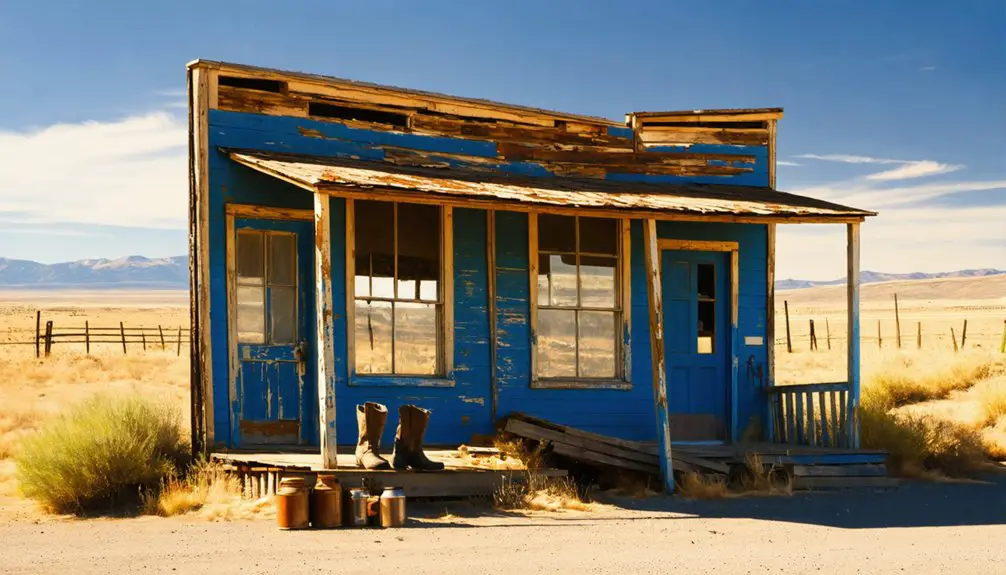You’ll find fascinating ghost towns scattered across Wasco County’s eastern Oregon landscape, each telling unique stories of the American West. From Shaniko, once the “Wool Capital of the World,” to Boyd’s abandoned mill town and Friend’s railroad hub, these settlements peaked during the early 1900s. The Great Southern Railroad‘s arrival in 1897 sparked their boom, while its closure in 1936 led to their decline. Today, preserved buildings and seasonal attractions in towns like Shaniko reveal tales of wool empires, stagecoach stops, and mysterious commune transformations.
Key Takeaways
- Wasco County’s ghost towns emerged during westward expansion, with many towns thriving as agricultural and railroad hubs in the late 1800s.
- Shaniko, once the “Wool Capital of the World,” now serves as a premier ghost town destination with preserved historic buildings.
- Boyd and Friend were agricultural communities that declined after Highway 197’s construction and the end of railroad service.
- Antelope transformed from a wool-shipping hub to the controversial Rajneesh commune before returning to a small rural community.
- These ghost towns maintain original structures and offer seasonal tourism opportunities, preserving the region’s rich cultural heritage.
The Rise and Fall of Wasco County’s Forgotten Communities
While westward expansion fueled the emergence of numerous frontier settlements across Oregon in the late 1800s, Wasco County’s ghost towns tell a particularly poignant story of boom and bust.
You’ll find towns like Wasco and Friend once thrived as essential hubs for wheat farmers and ranchers, with bustling main streets featuring banks, hotels, and saloons. The arrival of railroads, especially the Great Southern, transformed these outposts into economic powerhouses. The Columbia Southern Railroad reached Wasco in 1897, leading to a significant population surge in the early 1900s. The railroad’s final run in 1936 marked the beginning of Friend’s decline into abandonment.
But progress proved a double-edged sword. As farming techniques modernized and the Great Depression hit, these once-vibrant community dynamics shifted dramatically.
Boyd: A Legacy of Farming and Milling
As freight wagons and pack animals trudged toward eastern Oregon’s goldfields in the 1850s, Boyd emerged as an essential stagecoach stop along Fifteenmile Creek.
You’ll find its roots in the fertile creek-bottom soil, where pioneers like Daniel Bolton established the foundations of community agriculture that would define the town’s character.
T.P. Boyd’s mill became the heartbeat of this burgeoning settlement, transforming local wheat into flour and establishing a milling heritage that would sustain 150-200 residents at its peak. Today, only one abandoned home and an old barn remain as silent witnesses to the town’s prosperous past.
By 1895, you’d have found a proper town with a Methodist church, blacksmiths, and wheelwrights. The town’s development was marked by the establishment of a post office and store, where residents could conduct their daily business.
But progress proved unforgiving – the 1923 Highway 197 bypassed Boyd, and when the Great Southern Railroad ended service in 1936, the town’s decline became inevitable.
Friend: Where the Railroad Once Thrived
Like many railroad-era settlements in Wasco County, Friend sprang to life with the arrival of steel rails and the promise of prosperity.
You’ll find the legacy of the Great Southern Railroad‘s 41-mile line that connected The Dalles to Dufur, operating from 1904 to 1936, deeply woven into Friend’s story.
Today, you can explore the remnants of this community’s railroad impact through its empty schoolhouse with its distinctive steeple, the old general store, and post office built on George J. Friend’s original homestead.
The town’s community resilience showed in its farming and logging operations until the railroad’s closure sealed its fate.
While most physical traces of the tracks have vanished, Friend’s abandoned structures and quiet cemetery stand as silent witnesses to the brief but vibrant era of railroad-driven pioneer life.
Similar to nearby Shaniko, which generated over five million dollars in wool sales by 1904, Friend relied heavily on its railroad connections for economic prosperity.
Situated at an elevation of 3,343 feet, Shaniko’s high-desert landscape provided ideal conditions for sheep grazing and wool production.
Shaniko: From Wool Capital to Historic Landmark
You’ll find Shaniko’s remarkable transformation from an 1879 stagecoach stop called Cross Hollow to the “Wool Capital of the World” by 1903, when the town shipped millions of pounds of wool annually valued up to $5 million.
Visitors can now explore unique attractions including the bright green Shaniko Schoolhouse and the Sage Museum which displays local artifacts and historical photographs.
The town’s historic buildings, including the restored 1901 Shaniko Hotel, two-story city hall, and former Columbia Southern Railway depot, stand as evidence to its prosperous era when the population reached 600 residents. The arrival of the first train in 1900 marked the beginning of Shaniko’s boom town period.
While only about 30 people call Shaniko home today, you can experience this semi-ghost town’s rich heritage through tours of preserved structures and annual events that celebrate its wool-trading legacy.
Rise to Economic Glory
When the Columbia Southern Railroad arrived in May 1900, Shaniko’s transformation from a modest settlement into the “Wool Capital of the World” began.
You’d witness unprecedented economic resilience as the town shipped over 2,229 tons of wool and 1.1 million bushels of wheat annually, becoming one of the nation’s most productive short rail lines.
The community identity flourished as B.F. Laughlin and W. Lord built Oregon’s largest wool warehouse, enabling wool sales that reached five million dollars by 1904.
The Shaniko Hotel, built in 1900, became a symbol of the town’s prosperity and later earned a spot on the National Register of Historic Places.
You’d find freight wagon trains arriving from Burns, Bend, and Bridge Creek to trade at this bustling hub. The local newspaper, the Shaniko Leader, proudly declared the town second only to Portland as a shipping point.
Unfortunately, the construction of a new railway route in 1911 marked the beginning of the town’s economic decline.
Heritage Buildings Still Standing
Today’s visitors to Shaniko’s Historic District find a carefully preserved 12.8-acre collection of Old West architecture that earned national recognition in 1982.
You’ll discover the crown jewel of heritage preservation – the Italianate-styled Shaniko Hotel, built in 1900 with 18-inch thick brick walls, now renovated to offer 18 guest rooms with Mount Hood views.
The district’s architectural significance shines through other landmarks: the restored 1901 schoolhouse that serves as a community hall, the historic water tower that once pumped from Cross Hollow Canyon, and the Wool Warehouse that symbolizes Shaniko’s economic heyday.
You can explore the Wedding Chapel, City Hall and Jail, and Livery Barn-turned-museum, all featuring classic false fronts and boardwalks that transport you to Oregon’s wool boom era.
Modern Tourism Draws Visitors
Despite its diminutive population of just 30 residents, Shaniko has transformed from Oregon’s historic wool capital into one of the state’s most intriguing ghost town destinations.
You’ll find tourist engagement peaks between April and September when seasonal businesses along Shaniko Row welcome visitors seeking authentic ghost town experiences.
- Explore the newly reopened Shaniko Hotel, which enhances your overnight stay options while maintaining the town’s historic character.
- Visit preserved landmarks including the old jail, marshall’s office, and vintage car displays.
- Capture photos of well-maintained 19th-century architecture while listening to local caretakers share stories of the town’s sheep-raising heyday.
- Experience the quiet solitude of this 0.5-square-mile hamlet, where the aging population and limited development preserve its genuine ghost town atmosphere.
Antelope: A Ranch Town’s Unique Transformation
You’ll find Antelope’s original 1872 stage stop buildings standing alongside remnants of the controversial Rajneesh era, when this tiny ranching outpost was briefly transformed into a spiritual commune complete with luxury hotels and casinos.
The town’s dramatic shift from a wool-shipping hub of 50 residents to a renamed “Rajneesh” settlement in 1984 ended abruptly after criminal activities forced the cult’s departure in 1985.
Today’s quiet streets and empty storefronts, including the historic general store from 1897, tell the story of Antelope’s remarkable journey from frontier commerce to cult stronghold and back to a ghost town with fewer than 40 residents.
From Ranchers to Rajneesh
The tale of Antelope, Oregon presents one of the American West’s most dramatic transformations – from a bustling frontier town to the site of a controversial cult commune.
When you explore this remote Wasco County settlement, you’ll discover how the Rajneesh community impact fundamentally altered the town’s character in the early 1980s. The cult influence legacy remains evident in the town’s history, where hundreds of red-clad followers transformed a quiet ranching community into their vision of utopia.
- The commune purchased vast tracts of land and built luxurious facilities, including a 145-room hotel and casino.
- They renamed the town “Rajneesh” in 1984 after taking control through mass voter registration.
- Residents endured 12-hour workdays and strict control under cult leadership.
- Federal investigations uncovered criminal activities, leading to the commune’s collapse by 1985.
Empty Buildings Tell Stories
Standing silently along Antelope’s dusty streets, empty buildings chronicle the town’s remarkable evolution from an 1872 stage stop to a controversial commune and back again.
You’ll find abandoned structures that span generations – from the lone survivor of the 1898 fire to the elaborate 145-room hotel built during the Rajneesh years.
Through architectural storytelling, each building reveals a chapter of transformation: simple ranch-town structures stand beside the remnants of an ambitious utopian experiment.
While the former Rajneesh compound now serves youth campers as Washington Family Ranch, most of Antelope’s historic buildings sit vacant.
A handful of businesses – the post office, café, and bookstore – still operate, but the quiet streets and empty storefronts testify to the dramatic shifts that have shaped this remarkable Wasco County community.
Preserved Architecture and Notable Structures

- You’ll find false-front buildings lining Main Street, where original wooden facades showcase classic Western boomtown design.
- The restored Shaniko Hotel stands as the town’s centerpiece, complete with period-correct clapboard siding and pitched roof.
- Massive wool warehouses that once stored 4 million pounds of wool remain as evidence to the region’s economic power.
- Original frontier homes dot the landscape, featuring simple rectangular designs and front porches typical of early homesteader architecture.
The Role of Railways in Town Development
You’ll find that Wasco County’s ghost towns owe much of their initial growth to the Columbia Southern Railroad, which arrived in 1897 and transformed Wasco into a bustling agricultural hub handling over 200,000 sacks of wheat annually.
The railroad’s presence sparked rapid population growth, with Wasco’s residents increasing from 386 in 1910 to 701 in 1920, while attracting essential businesses like the North Pacific Flouring Mills.
When rail service ended in 1936 and the line was abandoned in 1966, many towns along the route experienced sharp population declines, with Wasco’s numbers dropping to 400 by 1930, marking the beginning of their shift toward ghost town status.
Railroad Rise and Fall
As the Columbia Southern Railroad began construction from Biggs toward Shaniko in 1897, Wasco County entered a transformative era of rail-driven development.
You’ll find evidence of this railroad expansion in the historic passenger station and freight warehouse, now preserved on the National Register of Historic Places.
- By 1897, you could spot 200,000 sacks of wheat lined up along Wasco’s tracks, showcasing the region’s agricultural might.
- The town’s population surged from 386 to 701 between 1910-1920, as rail access opened new markets.
- You’d see intense competition unfold as the Oregon Trunk and Des Chutes railroads raced to build parallel tracks along the Deschutes Canyon.
- Economic decline hit hard during the Great Depression, dropping Wasco’s population to 400 by 1930, eventually leading to the Columbia Southern’s abandonment in 1966.
Early Transit Development Patterns
Before railroads transformed Wasco County’s landscape, pack and saddle trains dominated the region’s freight transport, with caravans of up to 50 horses and mules traversing rugged terrain to reach mining settlements.
You’ll find that transit innovations emerged gradually, as express lines like Todd & Co. connected Oregon’s mines to California and Portland in the early 1850s.
The real freight evolution began after 1864, when roads suitable for stages and wagons finally appeared.
You can trace how the Oregon Trail’s southward shift through Wasco County’s vicinity shaped these early transit corridors.
These stagecoach and wagon routes became the blueprint for future transportation networks, setting the foundation for the railway boom that would revolutionize the region’s connectivity and economic prospects.
Daily Life in Early Settlement Days

When settlers first established communities in Wasco County during the late 1800s, their daily routines centered around the harsh realities of frontier life.
You’d find most residents working from dawn to dusk, whether tending to expansive wheat fields or managing livestock on the open range.
- You would’ve heated your modest wooden home with wood or coal stoves, drawing water from wells or nearby rivers for cooking and cleaning.
- For basic supplies and community gatherings, you’d visit multi-purpose buildings that served as post offices, general stores, and social hubs.
- Your farm equipment repairs meant regular visits to the local blacksmith, crucial for maintaining your livelihood.
- You’d attend church not just for worship, but as a significant connection point with neighbors scattered across the rural landscape.
Historic Industries That Shaped These Towns
The historic industries of Wasco County’s ghost towns centered on wool production, with Shaniko emerging as the undisputed “Wool Capital of the World” in the early 1900s.
You’ll find an industrial legacy spanning 20,000 square miles, where Shaniko’s massive wool warehouses processed millions of pounds annually, generating $5 million in sales by 1904.
The community evolution began with gold discoveries in 1862, as mining camps transformed into supply hubs like Cross Hollows and Bakeoven.
When the Columbia Southern Railway arrived in 1900, it revolutionized transportation, enabling cattle ranchers to fill 400 railroad cars during peak years.
This prosperous era ended when the Oregon Trunk Railway diverted traffic in the 1910s, though agriculture and infrastructure projects briefly sustained the region’s dwindling populations.
Modern Tourism and Ghost Town Preservation

Modern efforts to revitalize Wasco County’s ghost towns have transformed these former wool and mining powerhouses into compelling heritage tourism destinations.
You’ll find Shaniko leading the way in ghost town tourism, with its restored historic hotel and new shops drawing visitors year-round. The region’s preservation efforts balance tourism growth with protecting fragile historic structures.
Shaniko stands as a pioneer in ghost town preservation, carefully restoring historic buildings while welcoming modern tourism to its storied streets.
- Visit during annual music festivals and jamborees in Shaniko for an authentic cultural experience
- Explore Boyd and Friend’s historical granaries and schoolhouses along scenic driving routes
- Stay at the restored Shaniko Hotel, managed by a dedicated community of about 30 residents
- Experience living history through cultural events that celebrate the area’s wool industry heritage
These preservation initiatives continue to attract heritage tourists while supporting local economic development through seasonal events and regional tourism partnerships.
Frequently Asked Questions
Are Any of These Ghost Towns Dangerous to Visit?
You’ll face real dangers without proper safety precautions – from collapsing structures to wildlife encounters. Follow ghost town regulations, watch for hazards, and don’t explore remote areas alone.
Can Visitors Stay Overnight in Any of These Ghost Towns?
Like tumbleweeds in a ghost town, your overnight options are scarce. You can’t legally stay within these towns – there aren’t any camping options or overnight accommodations. Look to nearby cities for lodging instead.
What’s the Best Time of Year to Explore Wasco County’s Ghost Towns?
You’ll find the best exploring during fall, when seasonal weather brings ideal conditions with temperatures in the 50s-70s°F, fewer crowds, open amenities, and clear skies for photographing historic structures.
Are Metal Detectors Allowed When Visiting These Historic Sites?
Like Indiana Jones, you’ll need proper authorization first – metal detecting regulations strictly limit treasure hunting at these sites due to historical preservation concerns. Always obtain permits and landowner permission.
Do Any Paranormal Investigation Groups Regularly Explore These Ghost Towns?
You won’t find regular paranormal investigation groups in Wasco County’s ghost towns. While there are occasional paranormal sightings and independent ghost tours, organized teams don’t maintain consistent research schedules in these locations.
References
- https://en.wikipedia.org/wiki/List_of_ghost_towns_in_Oregon
- https://www.pdxmonthly.com/travel-and-outdoors/oregon-ghost-towns
- https://www.atlasobscura.com/places/friend-ghost-town
- https://www.deviantart.com/austinsptd1996/journal/Six-Iconic-Ghost-Towns-Within-Oregon-1109696435
- http://genealogytrails.com/ore/ghosttowns.html
- https://www.youtube.com/watch?v=TCR5ViL2WIQ
- https://crookcountyhistorycenter.org/2025/01/wasco-oregon-a-frontier-town-with-deep-roots/
- https://bestofthenorthwest.com/shaniko-oregon-a-step-back-in-time-on-the-high-desert/
- http://pnwphotoblog.com/boyd-oregon-ghost-town/
- https://www.youtube.com/watch?v=YN_v3AsKbI0



